Carrying Fire in a Horn
No Country For Old Men isn’t really about Anton Chigurh. He’s the most dynamic, vivid and quotable character in the whole movie, to be sure. He moves with a mountain lion’s terrifying coolness. But he’s not a real person. He’s no more real than John Galt in Atlas Shrugged, or Mr. Sunday in The Man Who Was Thursday, or Aslan in The Chronicles of Narnia. He’s a philosophy made flesh. Like all of Cormac McCarthy’s better stories – and most of the Coen Brothers’ better movies – No Country For Old Men is about the futility of human planning in the face of inevitable death. It’s just that, in this movie, Javier Bardem is the Face of Inevitable Death.
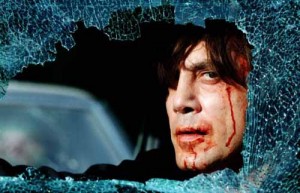
No Country For Old Men‘s ghost ship moment comes in the very last frame when (SPOILER ALERT) Sheriff Bell realizes that, by having lived to an older age than his father, he has aged past the point where he can effect change in the world.
Sheriff Bell and Anton Chigurh never share the screen in this movie. They never interact. The closest they come is when Sheriff Bell finds evidence of Chigurh’s presence: the shootout in the desert gulch. The shot-out doorknob in Llewellyn Moss’s trailer. The motel where Moss breathed his last. Bell is not, and cannot be, an agent of change. He can only show up after the fact, report on what he’s found, and drive away shaking his head.
Throughout the movie, Sheriff Bell shares his observations about the baffling state of the modern era (“modern,” remember, being Texas in 1980). He reads in the newspaper about a couple that would rent out rooms to seniors, kill them, then fraudulently collect their Social Security checks. But they would torture the seniors first. Later, he kvetches with a fellow sheriff over the insensibility of drug-related violence. They complain about kids with green hair and piercings who no longer say “sir” and “ma’am.” Really? That’s what the problem is?
He’d Have To Put His Soul at Hazard
Who are the “kids” in this movie?
Llewellyn Moss, the retired welder who finds the two million in drug money, is younger than Sheriff Bell by several decades. While not quite a kid, he retains the athletic optimism of youth. He slaps away Col. Wells’ offer of aid while laying up, bleeding and exhausted, in a Mexican hospital – even once Wells lays out the danger Moss is in. He thinks he can evade not just the law (in the person of Sheriff Bell), but a gang of drug-running Mexicans and an unusually persistent assassin. That’s action movie logic, and Llewellyn Moss doesn’t live in an action movie.
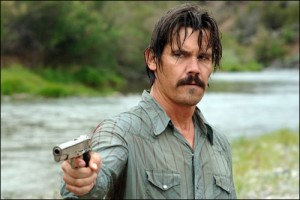
Looking badass won't save you.
Moss’s common-law wife, Carla Jean, treats Sheriff Bell’s offers of aid with skepticism. “They won’t stop,” Bell warns her. She counters: “He won’t, neither.” Bell’s best effort is to tell her a story of questionable provenance, regarding a cattle man and an unfortunate injury, and hope that she gets the drift. She calls Bell in on her own accord, but only after the situation has grown desperate.
We do meet two sets of actual children in the movie. Moss meets a trio of partying college kids as he crosses the border into Mexico and Chigurh meets a pair of biking pre-teens after his car accident in Odessa. In both cases the men, grievously injured, buy an article of clothing off the children (a jacket in Moss’s case; a shirt for Chigurh). The kids both express concern over the state of the men, but eventually fall to bickering over the money. It’s clear that these men are criminals: who crosses the Mexican border on foot while bleeding profusely? who flees the scene of a car accident, telling the witnesses, “you never saw me”? But it doesn’t take much money to lure these children in as accomplices.
Of What Use Was The Rule?
Both No Country For Old Men and A Clockwork Orange are about the inability of social institutions to deal with the violence of youth.
The source of that violence springs from different sources, depending on which film you’re watching. Alex’s violence in A Clockwork Orange comes from his deep, weird views on beauty. He hates weakness and corruption; he loves power and vitality. He will do whatever it takes to inflict those views on the world, remaking the world in his image and likeness. His is the exuberance of youth without the constraint of law.
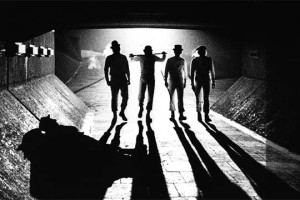
The violence of the various youth in No Country For Old Men – the Mexican gangs, the accommodating teenagers and Llewellyn Moss – comes from something simpler: a lust for gold. Moss could have avoided the trouble by leaving the satchel full of money where it lay. He could have saved his wife by leaving the money where the Mexicans, or Chigurh, could find it. But he didn’t. The teenagers who find Moss and Chigurh in their injuries go from compassionate to sickly curious to openly covetous once money enters the picture. Wealth, and its corrupting effects, free the youth of Texas from social order.
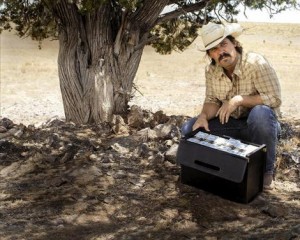
The criminal justice system cannot deal with the children in either case. The English prisons resort to psychological torture, seeing Alex’s inhumanity and raising it in turn. In Texas, meanwhile, Sheriff Bell throws his hands in the air. He won’t strap on his gun to go hunting Chigurh in the night; he won’t chase Moss down if Moss refuses to come in. Tommy Lee Jones, as Sheriff Bell, projects nothing throughout the film except a state of tired reluctance: a weary chuckle that lacks even the venom to be called ‘cynical.’
The system of justice – the institution of law and order – aims to impose sense on a chaotic world. But different generations operate on different logic. “The virtues of war are the virtues of young men,” observed Prince Feisal in Lawrence of Arabia. “The vices of peace are the vices of old men.” The old cannot make sense of the young, despite having once been young themselves. The young sell out, becoming cops (like Dim and Georgie in A Clockwork Orange) or hired guns for the men in suits (like Col. Wells in No Country for Old Men). Then they turn old and forget the ambition and lust of youth.
Social institutions should be shaping the youth of today into the old men of tomorrow. What do children look to when they don’t have guidance? Cheap thrills. Easy money. Rough violence. Casual sex. Beethoven.
The senselessness of the young means they live in another country from the old, and can only be made to fit in by reassembling them like clockwork.
An aged man is but a paltry thing,
A tattered coat upon a stick, unless
Soul clap its hands and sing, and louder sing
For every tatter in its mortal dress,
Nor is there singing school but studying
Monuments of its own magnificence;
And therefore I have sailed the seas and come
To the holy city of Byzantium.
– William Butler Yeats, “Sailing to Byzantium”
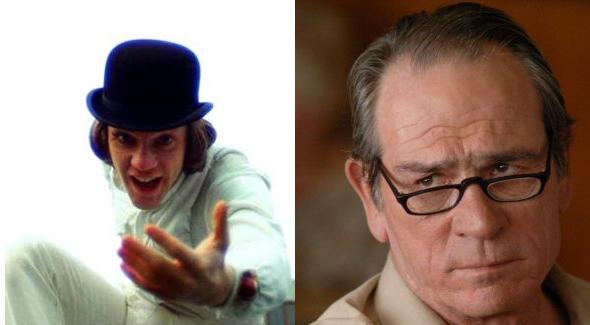
Of course, the most intriguing thing I found about No Country For Old Men was what doomed Llewellyn Moss–it wasn’t his criminality or brutality or lawlessness.
It was him making the decision to bring water to the dying shootout victim in the desert. And he knew it at the time, saying that it was a bad decision. Moss was doomed by the humanity that Anton Chigurh lacked.
Institutions can do nothing to stop someone, so long as they are vile and clever enough to get what they want.
A small quibble on an otherwise excellent article: these stories are not about society’s inability to deal with youth violence, but rather about society’s unwillingness to deal with the sources of youth violence.
@Valatan: I don’t know that going back to give the man water was what doomed Moss. Remember, the money case had that transponder in it from the beginning. As soon as Moss steps into the world of drug-runners and corruption – by choosing to take the money – he’s doomed.
I think the movie’s point is that you can’t plan your way out of trouble; you can’t plot a path that will save you from random, senseless brutality. Or, as Chigurh puts it to Wells, “If the rule you followed led you to this place, of what use was the rule?”
@GW: Normally I’d say “tomato, tomahto,” but I’m intrigued. Could you elaborate?
I agree this is a very insightful article. I spent quite awhile reading and pondering it bit by bit.
However, I disagree that the answer is necessarily to be found within social institutions. As Antonin Scalia has said many times when discussing why the Constitution cannot be interpreted in light of current societal mores – “who decides?” As a nation we cannot even get more than 51% of our voters to agree on one man for President. How are we then to agree on the framework along which youth are to be guided?
The fact also remains that ultimately social institutions have fleeting contact (and thus inconsistent and ineffective results) with youths. You really do have to start in the home, with the parent(s). Just like to stop the cycle of domestic violence, you have to start with girls as young as late elementary school, working on their self-esteem and teaching them independence, self-sufficiency, and what is and is not acceptable behavior in a relationship. And with boys, you have to start just as young, teaching *them* how to be more secure, since domestic violence tends to be rooted in insecurity and powerlessness.
The question of how you stop the cycles when the parents are passing these same issues (insecurity, poverty, lack of education, abandonment, substance abuse, neglect) on to the next generation is one that I have yet to be resolved. So far it seems the best we can do is fight the inevitable tide and do our best to insulate society from the worst of the ones who can’t be fixed by physical means for short periods of time. It’s a high price to pay – in money on one side, and in freedom on the other.
Still – GREAT article, and definitely thought-provoking.
I think the effort to make both movie about youth violence was a stretch. As a story about violence in general, it made sense lust for power and greed (whichs is just another form of power-lust). It was even an interesting article on the differing worldviews of the young and old. But as a complete article on youth violence, it could have ended on page one.